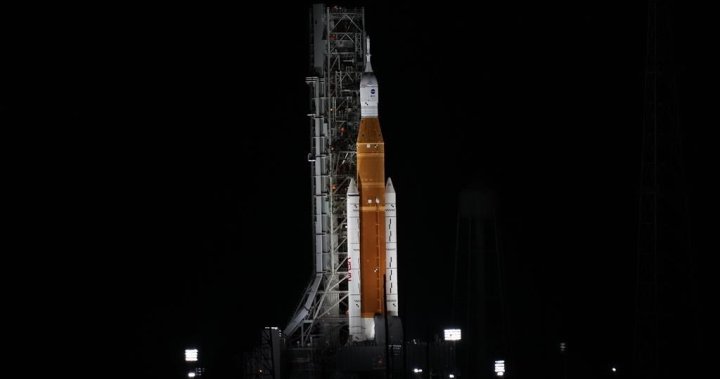The overwhelming, deafening, cataclysmic roar erupted and hurtled the Saturn V rocket — as tall as a 36-storey building — into the sky and then beyond.
Four days later the first person to visit another celestial body uttered the words now etched into our species’ history.
“That’s one small step for man, one giant leap for mankind.”
Neil Armstrong’s famous phrase, on July 21, 1969, was the culmination of a decade of American research and ingenuity — and billions of dollars. It sealed victory for the United States over the Soviet Union in a competition to land someone on the moon, a prestigious moment during heightened geopolitical tensions.
Many countries — and companies — are now starting or renewing their space programs, competing to reach the Moon’s South Pole, where there might be ice, and then Mars.
The United States (and aligned countries, including Canada) are hoping to land humans back on the moon by 2025, the Chinese by 2030.
India’s lunar lander could touch down on Wednesday while Russia’s was scheduled to try on Monday, but crashed.
A space law expert said the new space race might again look like the 1960s.
But he also warned it could more closely resemble European countries’ scramble to colonize new territory in the 16th and 17th centuries.
“Economic exploitation is something which causes competition and eventually leads to conflict and then destruction,” McGill professor Ram Jakhu told Global News.
“We should not expect governments or private companies to behave differently in space.”

Jakhu said there are trillions — not millions or billions — of dollars in potential resources at stake. Minerals and metals like iron, uranium, rare earth metals and a rare element called hellum-3, which is expected to play a major role in nuclear fusion technology.
It’s why so many countries and companies are now pushing ahead.
He said conflict could come from many more countries in space competing for the same resources. And having so many more entities in the same area creates greater risk of collisions or accidents, especially with every program contributing to space junk — garbage orbiting the planet that can knock out satellites and make spaceflight more hazardous.
Decades on the from Cold War, space has become one of the few areas where countries cooperate.
While American President Joe Biden and Russian President Vladimir Putin trade barbs on earth, American astronauts and Russian cosmonauts work side-by-side 400 kilometres above.
And countries, including the United States, Russia and China, signed and ratified the 1967 Outer Space Treaty, agreeing that space and all celestial bodies in it are “not subject to national appropriation by claim of sovereignty, by means of use or occupation, or by any other means.”
Jakhu said comments from NASA Administrator Bill Nelson show that era has ended.
“I don’t want China to get to the South Pole first with humans and then say, ‘This is ours. Stay out,’” Nelson told journalists on Aug. 8, referencing China’s expansive territorial claims in the South China Sea that violate an international court ruling.
“I think the space race is really between us and China… and I think we need to protect the interests of the international community.”

Nelson said the U.S.’s own Artemis Accords, an agreement between 28 countries including Canada, are designed to protect the ideals of peace and cooperation.
But Jakhu said the Accords aren’t binding.
And he said the U.S. has taken its own steps to reinterpret the treaty.
Section 10 of the Accords states, “Signatories affirm that the extraction of space resources does not inherently constitute national appropriation under Article II of the Outer Space Treaty.”
Former president Donald Trump signed an executive order in 2020 directing the U.S. government to object to another treaty, which the U.S. did not sign, that states the moon and any resources on it will not become property of any one state.
Barack Obama’s administration passed the 2015 Space Resource and Utilization Act to promote U.S. businesses exploring and utilizing outer space resources and states that any asteroid resources “are the property of the entity that obtained such resources.”
The Artemis Accords, Jakhu said, speaking from Montreal, is “a political move on the part of the United States to sell its interpretation of the law and getting like-minded countries to sign it.”
And while he admits cooperation on the International Space Station (ISS) — which China never joined — has been “exemplary,” he also pointed out the ISS has no commercial value.
“Space is not different from what we do on earth,” he said.

But planetary scientist Sara Mazrouei said the move away from cooperation will mean losing what helped countries get so far to begin with, not just in space exploration but with scientific advancement overall.
Instead of having geopolitics drive exploration, she said countries should follow the lead of the scientific community.
“I like to think how far we’ve come in the past 50 years,” she said.
“When I look at it from a scientist’s perspective, when I go to any space conferences (and) planetary science conferences, you see people coming together from all over the world and sort of their eyes are sparkling and everyone’s excited to share their new discoveries and get to see their colleagues from all around the world and really collaborate with them,” she said.
“Yes, we can get to the surface of the moon, but we want to go beyond that. Now, what can we achieve together?”




